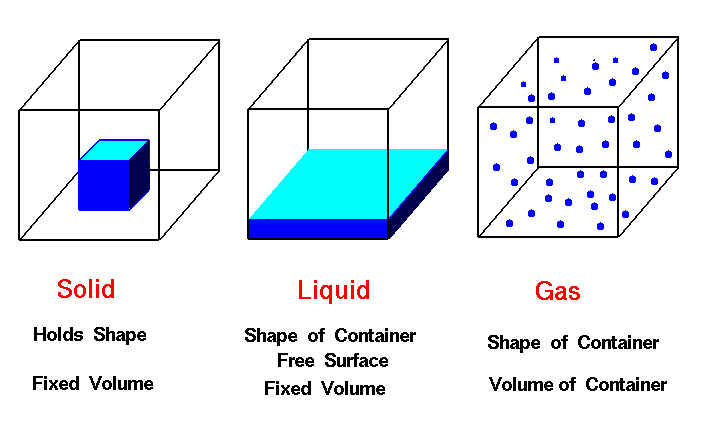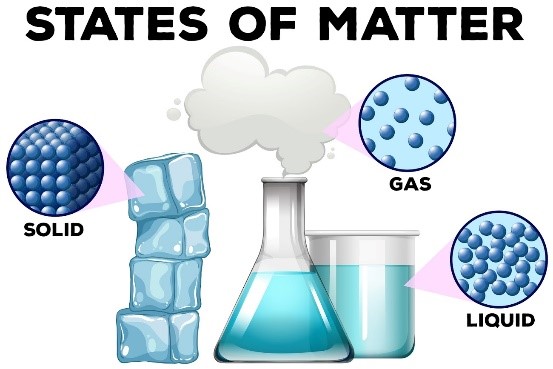States of Matter
Grade 6 Science Worksheets
The physical States of Matter
The universe is made of Matter. The tiniest of particles, Atoms, combine to form molecules, which are the building blocks for all forms of matter.
Matter exists primarily in three physical states– Solid, Liquid, and Gas. (See also: Matter and its Structure)
Schedule a Free session to clear worksheet doubts
No credit card required, no obligation to purchase.
Just schedule a FREE Sessions to meet a tutor and get help on any topic you want!
Properties of Matter
Solids have the following key properties–
- A definite form and Shape
- Hardness and Rigidity – they resist undergoing a change in shape easily (e.g. wood, stone)
- Some solids can be Brittle – they can shatter into pieces when struck (e.g. sulfur, salt)
- Some can be Ductileor Malleable– they can be drawn into wires or beaten into sheets(mostly metals)
Liquids have the following key properties –
- No shape of their own, such as water or gasoline
- Ability to Flow and take the shape of whatever they are held in
- Cannot be compressed easily

Gases have the following properties –
- No definite shape or volume, such as hydrogen or helium gas
- Exert Pressure and Expand in all directions to fill the closed container which they are held in
- Can be compressed into a very small space
- Cannot be confined to space in an open container
Personalized Online Tutoring from eTutorWorld
eTutorWorld offers affordable one-on-one live tutoring over the web for Grades K-12, Test Prep help for Standardized tests like SCAT, CogAT, MAP, SSAT, SAT, ACT, ISEE and AP. You may schedule online tutoring lessons at your personal scheduled times, all with a Money-Back Guarantee. The first one-on-one online tutoring lesson is always FREE, no purchase obligation, no credit card required.
For answers/solutions to any question or to learn concepts, take a FREE TRIAL Session.
No credit card required, no obligation to purchase.
Just schedule a FREE Sessions to meet a tutor and get help on any topic you want!
How Matter Changes State
How does a mercury thermometer, which displays the temperature, work? The mercury inside the thermometer is sensitive to temperature – it expands when the temperature rises and contracts when it falls. This tells us how hot or cold it is around us. The thermometer is an example of the effect of heat on matter.
The molecules of matter are in constant motion. When the matter is heated, the molecules start to vibrate even faster. As a result, the space between them increases and the matter expands. The reverse happens when the matter is cooled. The extent of heating or cooling applied to matter changes the state of that matter.
A solid when heated past its Melting Point will melt into liquid.
A liquid when heated past its Boiling Point will vaporize that matter into gas.
A gas when cooled below its Condensation Point will form liquid from that matter.
A liquid when cooled below its Freezing Point will form solid from that matter.
The chemical properties of the matter remain unchanged when they change from one state to another – only the physical properties change. Let us see with an example –

How Water Changes State
Water exists in three states in nature. It is abundantly seen in its liquid form.
Water has a boiling point of 100o Celsius (212oF). When water is heated past its boiling point, it vaporizes to form water vapor, a gas.
Water has a freezing point of 0o Celsius (32oF). When water is cooled below its freezing point it forms ice, a solid.
In all three states, the chemical properties of water remain the same – it is still just water – though its physical properties have changed.

Check Point
- Which of the following is NOT a property of a solid?
- Has a form and shape
- Flows easily
- Is ductile and malleable
- Does not undergo a shape change easily
- Which of the following is NOT a property of a gas?
- No definite shape or volume
- Exert pressure and expand in all directions
- Cannot be easily compressed
- Cannot be confined in an open container
- A solid which is heated past its melting point becomes ______.
- A gas which is cooled below its condensation point becomes ______.
- A liquid which is cooled below its freezing point becomes _______.
Answer Key
- b) Flows easily
- c) Cannot be easily compressed
- Liquid
- Liquid
- Solid
Schedule a Free session to clear worksheet doubts
No credit card required, no obligation to purchase.
Just schedule a FREE Sessions to meet a tutor and get help on any topic you want!
Learn more about Scientific Method and other important topics with 7th Grade Science Tutoring at eTutorWorld. Our expert science tutors break down the topics through interactive one-to-one sessions. We also offer the advantage of customized lesson plans, flexible schedules and convenience of learning from home.
Pricing for Online Tutoring
| Tutoring Package | Validity | Grade (1-12), College |
|---|---|---|
| 5 sessions | 1 Month | $124 |
| 1 session | 1 Month | $25 |
| 10 sessions | 3 months | $239 |
| 15 sessions | 3 months | $354 |
| 20 sessions | 4 months | $449 |
| 50 sessions | 6 months | $1049 |
| 100 sessions | 12 months | $2049 |
6th Grade Free Worksheets
- Inquiry process
- Nature of Science
- Scientific Inquiry
- Inquiry, Analysis and Problem Solving
- Ethical Practices
- Science and Society
- Biotic and Abiotic Factors
- Impact of Organisms
- Adaptation
- Spheres of Earth
- Natural Resources
- Environmental Issues
- Conservation of Earth
- Understanding Technology
- Abilities To Do Technological Design
- Structure of Earth
- Solar System
- Rocks and Fossils
- Earth Systems
- Plate Tectonics
- Evolution
- Magnetic Field of Earth
- Geologic Time
- Materials and Processes That Shape a Planet
- Astronomy
- Ecology
- Energy
- Kinetic and Potential Energy
- Energy Transfer
- Matter and its Structure
- States of Matter
- Physical and Chemical Changes
- Force and Motion
- Electricity and Magnetism
- Wave Interactions
- Sound
- Light
- Introduction to Life Science
- The Origin & History of Life On Earth
- Plant and Animal Cells
- Parts of a Cell
- The Cell Cycle
- How Living Organisms Get Energy
- Classification of Organisms
- How Plants Grow & Reproduce
- The Human Respiratory System
- The Human Cardiovascular System
- The Human Digestive System
- The Human Endocrine Systems
- The Human Nervous System
- The Human Muscular System
- The Human Skeletal System
Images Credit:
https://pixy.org/src/129/1297895.gif


